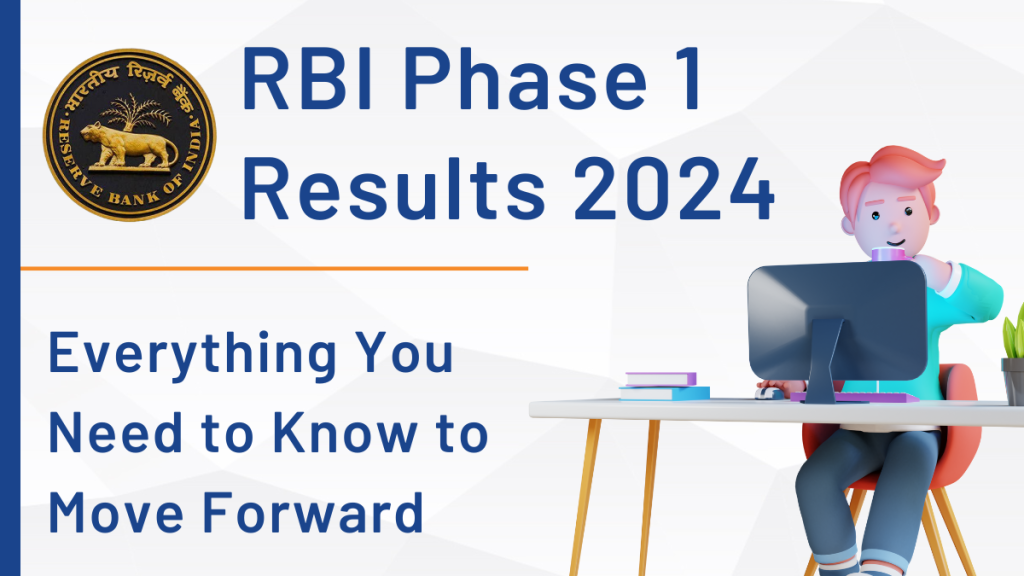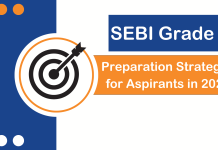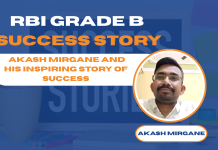The Reserve Bank of India (RBI) is one of the most prestigious institutions in the country, and its recruitment process for the Grade B Officers is nothing short of rigorous. With a highly competitive environment, the Phase 1 exam is the first step that candidates must take on their way to securing a job at the RBI. In this blog, we’ll dive deep into the specifics of the RBI Phase 1 results, what they mean for the candidates, and how to move forward after clearing or not clearing the first phase.
Clearing the RBI Phase 1 exam is a key step toward becoming an RBI Grade B Officer. The RBI results for Phase 1 determine eligibility for Phase 2 and reflect a candidate’s knowledge and ability to perform under pressure. Successful candidates must intensify their preparation for the next stage, while those who don’t pass should reassess their approach, focus on weaknesses, and prepare for future opportunities.

Overview of the RBI Phase 1 Exam
The RBI Grade B Phase 1 exam is the preliminary test that candidates must pass to move on to the Phase 2 examination. It consists of multiple-choice questions covering four main sections: General Awareness, Reasoning, English Language, and Quantitative Aptitude. The exam is designed to test the overall aptitude and intelligence of the candidates, ensuring that only the most competent move forward.
Since the RBI Phase 1 is an elimination round, its results are pivotal for candidates hoping to reach Phase 2. The cutoff marks for this phase are influenced by the number of vacancies, the difficulty level of the exam, and the overall performance of the candidates.
Announcement of the RBI Phase 1 Results
The results of the RBI Phase 1 exam are usually announced a few weeks after the exam date. In 2024, the results are expected to be announced online, just like previous years. The results are published on the official RBI website, and candidates must log in using their credentials to check their scores and qualification status.
The result page will include the following details:
- Roll numbers of the candidates who have cleared RBI Phase 1.
- Official cutoff marks for the various categories (General, OBC, SC, ST, etc.).
- Announcement of dates for the Phase 2 exam.
The RBI results not only indicate whether a candidate has cleared the phase but also serve as a guidepost for those who want to understand how competitive the exam was and where they stand in comparison to other candidates.
Table 1: RBI Phase 1 Exam Structure
This table outlines the structure of the RBI Phase 1 exam to help candidates understand the breakdown of marks, duration, and weightage of each section.
| Section | Number of Questions | Maximum Marks | Time Duration |
| General Awareness | 80 | 80 | Composite Time: 120 minutes |
| Reasoning | 60 | 60 | |
| English Language | 30 | 30 | |
| Quantitative Aptitude | 30 | 30 | |
| Total | 200 | 200 | 120 minutes |
What Happens After the RBI Phase 1 Results?
Upon clearing the RBI Phase 1 exam, candidates must prepare for the more challenging Phase 2. The Phase 2 examination is where RBI delves deeper into the specific knowledge required for the role. According to the official announcement, Phase 2 for RBI Grade B will include:
- Paper-III: General Finance and Management (Morning session)
- Paper-I: Economic and Social Issues (Afternoon session)
- Paper-II: English (Writing Skills)
The RBI Phase 2 exam is more in-depth and requires serious preparation. The admit cards for the Phase 2 exam will be available for download on the RBI website shortly after the announcement of the RBI Phase 1 results.
Cutoff Marks: A Critical Factor in RBI Phase 1 Results
The cutoff marks for the RBI Phase 1 exam are important for determining if a candidate will move to the next stage. These cutoffs vary year by year and are impacted by several factors:
- Number of candidates: More candidates mean tougher competition, often resulting in higher cutoffs.
- Vacancies: The number of available positions greatly impacts the cutoff marks.
- Difficulty level: If the exam is deemed easier by candidates, cutoffs can soar; conversely, difficult exams often result in lower cutoffs.
- Category: RBI follows the reservation policy, and hence the cutoff marks differ for General, OBC, SC, ST, and PwBD candidates.
For 2024, the RBI Phase 1 cutoff will be made available along with the individual marksheets within 15 working days of the result declaration. This interactive display of results allows candidates to gauge their performance not only against the cutoff but also against their peers.
Table 2: RBI Phase 1 Cutoff (2023 Example)
This table provides an example of category-wise RBI Phase 1 cutoff marks from a previous year (2023). It helps readers understand the competitive nature of the exam and gives them a benchmark to target.
| Category | Overall Cutoff Marks (out of 200) |
| General | 120.00 |
| OBC | 110.50 |
| SC | 97.00 |
| ST | 85.00 |
| EWS | 117.50 |
| PwBD | 75.00 |
What to Do If You Clear RBI Phase 1
Clearing RBI Phase 1 is a great achievement. Next, download your Phase 2 admit card, focus on advanced preparation, revise key topics, and stay updated on exam notifications and schedules for success:
- Download the Phase 2 admit card: Once the results are announced, the link to download the Phase 2 admit cards will be made available on the official RBI website. Ensure you download both the morning and afternoon session admit cards.
- Prepare for Phase 2: The Phase 2 exam is more specific and technical, focusing on areas like Finance, Management, Economic and Social Issues, and English Writing Skills. Make sure to prioritize these topics in your study plan.
- Gather study materials: From textbooks to online courses, there are ample resources to prepare for Phase 2. You can also seek guidance from coaching centers or use mock test series to evaluate your preparedness.
- Stay updated: Keep checking the RBI website for any further notifications or updates related to Phase 2.
What to Do If You Don’t Clear RBI Phase 1
Not clearing RBI Phase 1 can be disappointing, but it’s not the end. Analyze your performance, identify weak areas, improve your strategy, and stay focused to prepare better for future attempts:
- Analyze your results: Once the cutoff and your marks are made available, carefully analyze which sections you performed well in and where you struggled. This will help you target your preparation for future attempts.
- Plan for the next attempt: If you’re determined to crack the RBI Grade B exam, start preparing for the next year’s cycle. Use your performance in Phase 1 as a benchmark and work on improving your weak areas.
- Consider other exams: There are several other exams like the RBI Grade B, such as SEBI Grade A, NABARD Grade A , NABARD Grade B, and others. Prepare for these exams in parallel to increase your chances of landing a prestigious job in the banking and finance sector.
Key Tips to Ace RBI Phase 2
As you prepare for Phase 2, focus on effective study techniques, time management, practicing mock tests, understanding the exam pattern, and maintaining a positive mindset for success:
- Understand the syllabus: The Phase 2 exam is highly focused. Knowing the exact syllabus and sticking to it is crucial.
- Practice descriptive writing: Paper-II (English Writing Skills) will test your ability to write essays, précis, and comprehension. Regular practice is the only way to excel in this section.
- Focus on current events: Paper-I (Economic and Social Issues) often includes questions on recent economic developments, government schemes, and international relations. Stay updated with daily news and publications like The Hindu or Business Standard.
- Financial knowledge: Paper-III (General Finance and Management) requires a strong foundation in finance and management concepts. Books like Prasanna Chandra’s Financial Management or websites like Investopedia can be useful resources.
Preparing for RBI Phase 1: A Solid Strategy for Success
The RBI Phase 1 exam is the steppingstone to becoming a Grade B officer, and excelling in it requires strategic planning and focused preparation. This exam covers a wide range of subjects, including General Awareness, Reasoning, English, and Quantitative Aptitude. Candidates must be versatile in all these areas to ensure success.
- General Awareness: This section carries significant weight and often becomes the deciding factor in RBI Phase 1 results. Keeping up with daily current affairs, RBI updates, government policies, and international news is critical. Regular reading of newspapers and financial magazines can help sharpen your understanding of current events.
- Reasoning and Quantitative Aptitude: These sections test logical thinking and mathematical ability. Practicing questions from previous years’ exams and mock tests will help you get comfortable with the types of questions asked in RBI Phase 1. Candidates should focus on time management as well, as these sections can be time-consuming.
- English Language: The English section tests comprehension, grammar, and vocabulary. A good command of the English language is essential for clearing this section. Reading books, editorials, and practicing with sample papers can help improve language skills.
To crack RBI Phase 1, aspirants must practice regularly and take mock tests to assess their readiness. Online platforms offer numerous mock tests, designed to simulate the real exam experience, helping candidates gauge their performance and make necessary improvements before the actual exam.
RBI Results: Understanding What They Mean
The announcement of the RBI results is an important moment for all candidates. Once the results are published on the official website, candidates can check whether they’ve qualified for Phase 2. Along with the results, the RBI releases the cutoff marks for each category, allowing aspirants to understand how they fared compared to others.
For many, this phase can be filled with anticipation and anxiety. However, it’s essential to stay grounded and view the results as a learning experience. For those who have cleared RBI Phase 1, it’s time to gear up for the tougher challenges in Phase 2, which demands more subject-specific preparation, as discussed earlier.
The RBI results offer more than just a pass or fail status. They provide a chance for candidates to assess their strengths and weaknesses. For those who didn’t make it, the results act as a roadmap for future improvement. By analyzing the sections where they fell short, candidates can make targeted efforts to enhance their preparation for the next attempt.
Future Opportunities After RBI Phase 1 Results
If you’ve cleared the RBI Phase 1, congratulations! Now, it’s time to focus on Phase 2. However, if you didn’t make it through, don’t lose hope. The experience of preparing for and taking RBI Phase 1 is invaluable. It equips you with a strong foundation, not just for the RBI exam but also for other competitive exams in the banking and financial sector.
The RBI results are a steppingstone to greater opportunities. For those who didn’t clear the exam, it’s important to analyze the journey so far and identify areas of improvement. Each attempt brings you closer to your goal, and perseverance is key. With the right mindset and a refined strategy, success in future exams is well within reach.
Conclusion
The RBI Phase 1 results are a important milestone in the journey toward securing a prestigious RBI Grade B Officer post. Whether you’ve cleared the exam or not, it’s essential to stay motivated and focused on your long-term goals. For those advancing to Phase 2, it’s time to buckle down and prepare for the more advanced topics. For those who didn’t make the cut, use this experience as a steppingstone to refine your strategy and come back stronger next time.
In any case, the RBI Grade B exam is a gateway to a remarkable career in banking, and perseverance, coupled with smart preparation, is the key to success.
For aspirants targeting RBI exams like RBI Grade B DSIM, RBI Grade B, RBI Assistant, and RBI Grade B DEPR, ixamBee provides a complete RBI Grade B Online Course, RBI PYP (Previous Year Papers), and RBI Grade B Mock Tests to sharpen your skills for success. These resources offer in-depth preparation strategies. Additionally, upcoming government exams like SSC CGL and IBPS RRB PO also present excellent career opportunities, so stay prepared for those as well.
At ixamBee, we specialize in providing comprehensive online courses for government exams and online courses for government jobs. Our expertly designed courses for government jobs cater to a wide range of upcoming government exams. Whether you’re preparing for specific courses for government exams or seeking general guidance, ixamBee offers the resources like Beepedia previous year papers, SSC CGL, SSC CHSL, SSC MTS and other mock tests to succeed in exams like RBI Grade B, SEBI Grade A, NABARD Grade A, RRB NTPC, SSC MTS, NIACL Assistant, and more.
Also Read:
What are some dos and don’ts for the RBI Grade B exam?
SBI SO Notification and Tips: Everything You Need to Know
RBI Grade B 2024 Cutoff Prediction and Analysis















